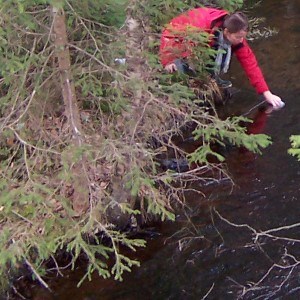Contact
Department of Aquatic Sciences and Assessment, Division of Geochemistry and Hydrology, laboratory

The light permeability of water depends on the presence of suspended particles and dissolved substances in the water. In a filtered water sample, it is chiefly the light absorption of dissolved substances that is measured. In natural water, the absorption is mainly influenced by the content of humic substances and certain iron and manganese compounds; then, one usually speaks of the colour of the water ("brownness").
The difference in absorbance between a filtered and an unfiltered water sample may be used to estimate the particle content in the water. The amount of particles can also be analysed as suspended matter or turbidity. The report “Change of method for measuring the haziness in lakes and water courses – AbsDiff replaced with turbidity 2010” (in Swedish) compares the analysis results between the difference in absorbance and turbidity.
Absorbance is measured using a spectrophotometer, while an older method for determining the colour of the water utilised a so-called colour comparator, where the water's colour was manually compared to various coloured filters. Earlier still, the colour of the water was compared to a dilution series of platinum cobalt chloride (the Pt/Co scale or Apha-Hazen Scale), which later was used to determine the colour scale of the filter of the comparator, hence the unit is in mg Pt/l (mg platinum per litre).
The comparator method has considerable disadvantages compared to the spectrophotometric absorbance method: first, it is a subjective method with large leaps between the scale steps; second, the most commonly used coloured plastic filters were vulnerable to light and became bleached over time. Conversion between the Pt/Co scale and absorbance is very uncertain, partly due to the greater uncertainty in colour determination and the discrete scale in the same method, partly because of great uncertainty in absorbance measurements of platinum cobalt chloride solutions, which is due to the absorbance curve of platinum cobalt chloride being very flat in the currently used wavelength range.
Estimates of the colour can be made by applying the absorbance value (filtered sample in 5 cm cuvette at 420 nm or 410 nm [according to SS-EN ISO 7887:2012]) to the formula:
Colour (mg Pt/l) ≈ 500 * Absorbance420
Colour (mg Pt/l) ≈ 390 * Absorbance410
According to international standards (SS-EN ISO 7887:2012), the spectrophotometric measurements are to be made in a 5 cm cuvette at 436 nm, but are usually made in Sweden by tradition at 420 nm. Recalculations are according to the same standard to be made from absorbance at 410 nm.
From June 2014 is the water laboratory also accredited for absorbance measurements at 254 nm, 365 nm and 436 nm, in addition to the earlier accreditation at 420 nm.
From December 2016 is the water laboratory also accredited for colour calculated from absorbance at 410 nm.
See information above about colour comparator as well as different wavelengths.
Valid since 1 November 2023
Method (254, 365, 420 samt 436 nm): SS-EN ISO 7887, del B, mod.
Method (colour): SS-EN ISO 7887, part C, mod.
Instrument: Spektrophotometer Shimadzu UV 2600i with 5 nm bandwith and sample changer Teledyne ASX280
2014-06 – 2023-10
Method (254, 365, 420, and 436 nm): SS-EN ISO 7887, part B, mod.
Metod (colour): SS-EN ISO 7887, part C, mod. (accredited from December 2016)
Instruments: Spectrophotometer PerkinElmer Lambda 35 with 4 nm bandwidth and sample changer.
1995-01 – 2014-05
Method: SS-EN ISO 7887:2011 (modified).
Instrument 2009-10 – 2014-05: Spectrophotometer PerkinElmer Lambda 35 with 4 nm bandwidth and sample changer.
Instrument 1995-01 – 2009-09: Spectrophotometer UNICAM 8625 with 8 nm bandwidth. 50 mm flow cuvette.
NB: Water was filtered through a 0.45 µm membrane filter.
1965-01 – 1994-12
Method: Chalupa, Jiri, 1963. Humic acids in water. 1 Methods of preparation and determination. Sbornik Vysoké skoly chemicko-technologické v. Praze. Technologie vody (A compilation of the water technology, Chemical & Technical University in Prague, in Czech) 7(1), 17-47. Absorbance of filtered (0.45 µm) and unfiltered samples measured at 420 nm in 5 cm cuvette.
1965-01 – 1978-12
Method: Standard Methods 10th Ed. 1955. Karlgren, L. 1961. Vattenkemiska analysmetoder (Hydrochemical Analitycal Methods, in Swedish).
Instrument: Hellige Nessler tube comparator.
 (Photo: Stefan Löfgren)
(Photo: Stefan Löfgren)